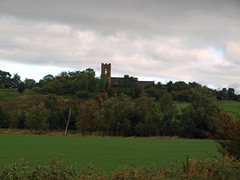On my way to East Tilbury from the fort TomTom took me past St James which sits on a lump - normally I'd describe it as a hill but in this alluvial plain that seems laughable, and even more so here in my native Essex - and I have to say it's rather striking from a distance.
Made redundant in 1979 St James is now a residential property - personally I don't like the re-distribution of the headstones but that's a matter for the Church Commissioners conscience, and may have happened long before the sale.
Basically a Victorian rebuild so not much of a loss but I imagine that as a house it's fantastic - I'd have a study at the top of the tower and do nothing all day but dream.
ST JAMES. Well placed on the edge of the escarpment looking to the S towards the river. The Royal Commission mentions an Early Norman window partly preserved in the N wall. This cannot now be seen. On the S side near the W end one deeply splayed lancet. Otherwise C1 windows. W tower of 1883. - PLATE. Chalices given in 1772 and 1797.
The church (at West Tilbury) stands among elms and chestnuts on the edge of the bold escarpment overlooking the meadows stretching to the Thames, and beyond to the hills of Kent. The rampart and the ditch of an ancient camp are close by, and it is believed to have been here that Queen Elizabeth reviewed her hosts. By the river is Tilbury Fort, with a gatehouse of 1682. There are traces of Norman windows in the nave and chancel of the church, and the walls are among the earliest Norman work in England, being 11th century; but the tower is modern with five 17th century bells hanging in it. On the floor of the nave is a coffin lid 700 years old with a moulded edge and a cross, and here is an ancient piscina and one or two medieval windows.
Flickr.

No comments:
Post a Comment